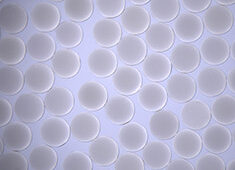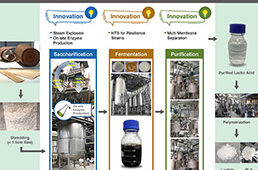Researchers at Rice
Univ. and Texas A&M
have discovered a way to pattern active proteins into bio-friendly fibers. The
“eureka” moment came about because somebody forgot to clean up the
lab one night.
The new work from the Rice lab of biochemist Kathleen Matthews, in
collaboration with former Rice faculty fellow and current Texas A&M
assistant professor Sarah Bondos, simplifies the process of making materials
with fully functional proteins. Such materials could find extensive use as
chemical catalysts and biosensors and in tissue engineering, for starters.
Their paper an online edition of Advanced
Functional Materials details a method to combine proteins with a
transcription factor derived from fruit flies and then draw it into fine,
strong strands that can be woven into any configuration.
Bondos and Matthews led the team that included primary author Zhao Huang and
research technician Taha Salim, both of Rice, and research assistants Autumn
Brawley and Jan Patterson, both of Texas A&M.
The research had its genesis while Bondos was in Matthews’ Rice lab studying
Ultrabithorax (Ubx), a recombinant transcription factor protein found in Drosophila melanogaster (the common
fruit fly). This protein regulates the development of wings and legs.
“It’s biodegradable, nontoxic, and made of naturally occurring proteins—though
we have no reason to believe that fruit flies ever produce enough of these
proteins to actually make fibers,” Bondos said.
It was a surprise, then, to find that Ubx self-assembles into a film under
relatively mild conditions.
“I was cleaning up in the lab one morning and I noticed what appeared
to be a drop of water suspended in midair beneath a piece of equipment I was
using the previous night,” Bondos recalled.
It turned out the droplet was water encased in a sac of Ubx film. The sac
was hanging by a Ubx fiber so thin that it was more difficult to see than a
strand of a spider’s web, Bondos said.
“It clued us in that this was making materials,” said Matthews,
Rice’s Stewart Memorial Professor of Biochemistry and Cell Biology and former
dean of the Wiess School of Natural Sciences.
The chance discovery prompted a 2009 paper in the
journal Biomacromolecules about the
material they dubbed “ultrax,” a superstrong and highly elastic
natural fiber.
“We found that if you put a little drop of this protein solution on a
slide, the Ubx forms a film. And if you touch a needle to that film, you can
draw a fiber,” Matthews said. “Then we asked, What if we could
incorporate other functions into these materials? Can we make chimeras?”
The answer was yes, though it took ingenuity to prove.
Chimeras in the biological world contain genetically distinct cells from two
or more sources. In Greek
mythology, chimeras are beings with parts from multiple animals; a pig with
wings, for instance, would qualify. But real chimeras are usually more subtle.
On the molecular level, chimeras are proteins that are fused into a single
polypeptide and can be purified as a single molecular entity.
As a proof of principle, the team used gene-fusion techniques to create
chimeras by combining Ubx with fluorescent and luminescent proteins to see if
they remained functional. They did. The combined materials still formed a film
on water. Drawn into fibers and put under a microscope, Ubx combined with enhanced
green fluorescent protein (EGFP) kept its bright green color. Ubx-mCherry was
bright red, the brown protein myoglobin (from sperm whales) was brown, and luciferase
glowed.
Huang was able to make patterns with strands generated by the chimeras by
twisting red and green fluorescent proteins into candy cane-like tubes, or
lacing them on a frame. “This patterning technique is pretty unique and
very simple,” said Huang, who recently defended his thesis on the subject.
He said making solid materials with functional proteins often requires harsh
chemical or physical processing that damages the proteins’ effectiveness. But
creating complex three-dimensional structures with Ubx is efficient and
requires no specialized equipment.
Bondos is studying how many proteins are amenable to fusion with Ubx.
“It looks like it’s a fairly wide range, and even though Ubx is positively
charged, both positively and negatively charged proteins can be
incorporated.” She said even proteins that don’t directly fuse with Ubx
may be able to connect through intermediary binding partners.
Bondos said the 2009 paper “showed we could make three-dimensional
scaffolds. We can basically make rods and sheets and meld them together;
anything you can build with Legos, we can build with Ubx.”
Ubx-based materials can match the natural properties of elastin, the protein
that makes skin and other tissues pliable, Bondos said. “You don’t want to
make a heart out of something hard, and you don’t want to make a bone out of
something soft,” she said. “We can tune the mechanical properties by
changing the diameter of the fibers.”
She said functionalized Ubx offers a path to growing three-dimensional
organs layer by layer. “We should be able to build something shaped like a
heart, and because we can pattern the chimeras within fibers and films, we can
build instructions into the material that cause cells to differentiate as
muscle, nerves, vasculature, and other things.”
Bondos suggested the material might also be useful for replacing damaged
nerves. “We should be able to stimulate cell attachment and nerve growth
along the middle and factors on the ends to enhance attachment to existing
nerve cells, to tie it into the patient. It really is pretty exciting.”
Matthews said the ability to characterize and pattern fibers for different
functions should find many uses, because enzymes, antibodies, growth factors
and peptide recognition sequences can now be incorporated into biomaterials.
She said sequential arrays of functional fibers for step-by-step catalysis of
materials is also possible.
“You’re only limited by your mechanical imagination,” she said.




